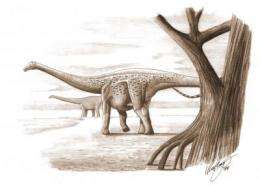A shrunken giant: Island dino Magyarosaurus was a dwarf, after all

Sauropod dinosaurs, like the famous Brachiosaurus or Argentinosaurus, are known above all for their enormous size. Yet some of these giants evolved into dwarfs. An international research team at Bonn University has now confirmed that the sauropod dinosaur Magyarosaurus dacus, a close relative of the Argentinosaurus, never grew any larger than a horse.
In 1895, the sister of an eccentric palaeontologist called Franz Baron Nopcsa discovered small dinosaur bones on their family estate in Transylvania. Nopcsa interpreted these as the remains of dwarfed animals that had once lived on an island. Among these finds were a number of bones belonging to a sauropod dinosaur which Nopcsa named Magyarosaurus dacus, after his native country.
A team of scientists led by Koen Stein and Professor Dr. Martin Sander from the University of Bonn, decided to cut up the fossil bones of the dwarfed dinosaur and study their microstructure. "It's astonishing that the microanatomy of these bones has been preserved for us to study after 70 million years," says Stein, who carried out the research as part of his PhD studies. "Bone is a living tissue, and throughout an animal's life it is constantly dissipating and building up again." Humans, for example, have completely resorbed and rebuilt their skeleton by the time they are fully grown. This also occurred in sauropod dinosaurs. "We were able to distinguish these rebuilding features in Magyarosaurus, which prove that the little dinosaur was fully grown," Koen Stein explains.
A dwarf among giants
Over the years, palaeontologists have frequently debated the question of whether or not the Magyarosaurus was a dwarf. Martin Sander, spokesperson of the Research Group on Sauropod Biology funded by Germany's central research funding foundation the DFG (Deutsche Forschungsgemeinschaft) notes, "An animal the size of a horse may not seem like a dwarf to most people but, in sauropod terms, it's tiny!" When Magyarosaurus was discovered in Transylvania (then part of the Austro-Hungarian Empire), the palaeontologist Nopcsa advanced the idea that Magyarosaurus was an island dwarf, but he could not prove it back then, at the beginning of the 20th century. Many discoveries have since indicated that his theory might be correct, especially the fossils of dwarf elephants and hippopotamuses found on Mediterranean islands like Sicily, Malta and Cyprus.
However, scientists first pursued a different theory. For in the subsequent decades, other researchers found big sauropod bones on the Transylvanian site. They therefore concluded that Magyarosaurus was simply a youngster, while the larger bones came from fully grown adults.
The study now being published provides conclusive evidence that Nopcsa's hunch had been right all along. "Our study shows that dinosaurs on islands were subject to the same ecological and evolutionary processes that shape modern mammals," explains Martin Sander. "We were also able to demonstrate that the bigger bones found in that area belong to a different dinosaur species." Whether they come from stray animals who swam to the island from the mainland, or from large ancestors of the dwarf Magyarosaurus, remains a secret shrouded in the mists of pre-historic time.
The team's findings are now to appear in the science journal Proceedings of the National Academy of Sciences.
More information: www.pnas.org/cgi/doi/10.1073/pnas.1000781107
Provided by University of Bonn


















